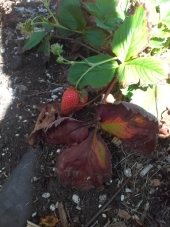I've mentioned this technique in a few other threads, but now it's time for it to give it its own name and its own thread. What is hoserkultur? It has nothing to do with those two hosers
Bob and Doug McKenzie, it's using your garden hose to create a hugelkultur environment for plants that are too big to uproot and move to a hugelkultur bed.
The two necessary pieces of equipment for hoserkultur are a sturdy garden hose and an adjustable
hose nozzle. The nozzle turns the hose into a soil drill, and it is possible to push this down into the root zone of a tree two or even three feet. Any more than three feet and the flexibility of the hose will take over and it will start to take off in a direction of its own choosing. If you want to drill down more than three feet, it is advisable to use a piece of galvanized pipe between the hose and the nozzle as part of your makeshift drilling rig.
Once you get the hang of letting the pressure of the water dig the hole for you, the process can go quite fast, and in a half hour or so, you can have multiple holes drilled along the dripline of a tree. After letting the water percolate out of the new hole, you can treat the hole like any new hugelkultur or lasagna bed and pack it with life giving nutrients for the tree. I like to use a well decayed piece of oak branch (I'm fortunate that there are plenty of oaks in the neighborhood dropping good sized branches) and once it is tamped into the hole as far as it will go, I top the hole off with a mix of biochar and wood chips.
Hoserkultur can really give a boost to a tree or a shrub that has been not thriving but just surviving. I drilled and filled 4 holes around each of my kiwi vines last January and they put on 3 times the growth that they had the previous year. Although you can do this any time of the year, it is not a great disturbance to the roots, it seems to me best to do it in the late winter, while plants are still dormant. That way the newly introduced soil fungi can get acclimated and be waiting for when the plant resumes its growth in the spring.
If you are dealing with issues of soil compaction, this is a cheap way to make a dent in the problem. While I was drilling, I noticed that the drill mud was as white as milk, which is not surprising as there is a commercial kaolin mine 2 miles down the road from me. That clay has been compacting for millions of years, and when it gets to a certain point, plant roots can't penetrate it and they just give up. If I want my trees to be drought resistant and able to access the water and minerals in the clay down there, I'm going to have to give them some help.
If you have any questions about this new technique, let's hear them. I don't think it is ever going to become a standard practice of industrial agriculture, but then again, who cares what those hosers do?

 8
8









 1
1












































